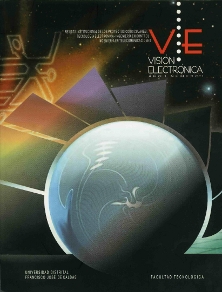DOI:
https://doi.org/10.14483/22484728.14665Published:
2018-05-22Issue:
Vol. 1 No. 1 (2018): Special editionSection:
A Research VisionEsteganografía de voz basada en cuantización mejorada
Speech steganography based on enhancement QIM
Keywords:
Capacidad de ocultamiento, Cuantización, Esteganografía, Señal huésped, Transparencia (es).Keywords:
Hiding capacity, Quantization, Audio steganography, Host signal, Imperceptibility (en).Downloads
Abstract (es)
Una de los mecanismos para transmitir información segura consiste en la utilización de técnicas esteganográficas, entre las cuales, QIM sobresale por proporcionar alta transparencia. Sin embargo, la capacidad de ocultamiento es relativamente baja. En este artículo, se presenta una mejora al método QIM con el objetivo de mantener una alta transparencia en la señal transmitida, pero cuadriplicando su capacidad de ocultamiento. Se realizaron numerosas pruebas para medir el efecto de cuantización tanto en la señal esteganográfica, como en el mensaje secreto recuperado.
Abstract (en)
One of the mechanisms for transmitting secure information consists of the use of steganographic techniques, among which, QIM provides high transparency. However, its hiding capacity is relatively low. In this paper, an improvement to the QIM method is presented in order to maintain a high transparency in the transmitted signal (i.e. stego signal), but increasing the hiding capacity (HC), by a factor of four times. Several tests were performed in order to measure the quantization effect on both the stego signal and the recovered secret message.
References
F. Djeebar, B. Ayad, K. Abed Meraim y H. Hamam, “Comparative study of digital audio steganography techniques”, EURASIP Journal on Audio, Speech, and Music Processing, vol. 2012, no. 25, 2012, pp. 1-16. DOI: https://doi.org/10.1186/1687-4722-2012-25.
N. Cvejic y T. Seppänen, “A wavelet domain LSB insertion algorithm for high capacity audio steganography”, IEEE Proceedings of Digital Signal Processing Workshop, and the 2nd Signal Processing Education Workshop, 2002, pp. 53-55. DOI: https://doi.org/10.1109/DSPWS.2002.1231075.
N. Cvejic y T. Seppänen, “Increasing the capacity of LSB-based audio steganography”, IEEE Workshop on Multimedia Signal Processing, 2002, pp. 336-338. DOI: https://doi.org/10.1109/MMSP.2002.1203314.
R. Sridevi y A Damodaram, “Efficient method of audio steganography by modified LSB algorithm and strong encryption key with enhanced security”, Journal of Theoretical and Applied Information Technology, vol. 5, no 6, 2009.
D. M. Ballesteros y J. M. Moreno, “Real-time, speech-in-speech hiding scheme based on least significant bit substitution and adaptive key”, Computers and Electrical Engineering, vol. 39, no. 4, 2013, pp. 1192-1203. DOI: https://doi.org/10.1016/j.compeleceng.2013.02.006.
S. Dumitrescu, X. Wu y Z. Wang, “Detection of LSB steganography via sample pair analysis”, IEEE Transactions on Signal Processing, vol. 51, no. 7, 2003, pp. 1995-2007. DOI: https://doi.org/10.1109/TSP.2003.812753.
D. E. Skopin, I. M. El-Emary, R. J. Rasras y R. S. Diab, “Advanced algorithms in audio steganography for hiding human speech signal”, IEEE 2nd International Conference on Advanced Computer Control, vol. 3, 2010, pp. 29-32. DOI: https://doi.org/10.1109/ICACC.2010.5486735.
H. Matsuka, “Spread spectrum audio steganography using sub-band phase shifting”, IEEE International Conference on Intelligent Information Hiding and Multimedia Signal Processing, 2006, pp. 3–6. DOI: https://doi.org/10.1109/IIH-MSP.2006.265106.
F. Djebbar, H. Hamam, K. Abed-Meraim y D. Guerchi, “Controlled distortion for high capacity data-in-speech spectrum steganography”, IEEE Sixth International Conference on Intelligent Information Hiding and Multimedia Signal Processing, 2010, pp. 212-215. DOI: https://doi.org/10.1109/IIHMSP.2010.60.
O. Yilmaz y S. Rickard, “Blind separation of speech mixtures via time-frequency masking”, IEEE transactions on Signal Processing, vol. 52, no. 7, 2004, pp. 1830-1847. DOI: https://doi.org/10.1109/TSP.2004.828896.
D. M. Ballesteros y A. Moreno, “Highly transparent steganography model of speech signals using Efficient Wavelet Masking”, Expert Systems with Applications, vol. 39, no. 10, 2012, pp. 9141-9149. DOI: https://doi.org/10.1016/j.eswa.2012.02.066.
B. Chen y G. W: Wornell, “Quantization index modulation: A class of provably good methods for digital watermarking and information embedding”, IEEE Transactions on Information Theory, vol. 47, no. 4, 2001, pp. 1423-1443. DOI: https://doi.org/10.1109/18.923725.
D. Renza, D. M. Ballesteros y C. Lemus. “Authenticity verification of audio signals based on fragile watermarking for audio forensics”, Expert systems with applications, vol. 91, 2018, pp. 211-222. DOI: https://doi.org/10.1016/j.eswa.2017.09.003.
D: M. Ballesteros, D. Renza y R. Rincón, “Gray-scale images within color images using similarity histogram-based selection and replacement algorithm”, Journal of Information Hiding and Multimedia Signal Processing, vol. 6, no. 6, 2015, pp. 1156-1166.
N. K. Kalantari y S. M. Ahadi, “A logarithmic quantization index modulation for perceptually better data hiding”, IEEE Transactions on Image Processing, vol. 19, no. 6, 2010, pp. 1504-1517. DOI: https://doi.org/10.1109/TIP.2010.2042646.
N. K. Kalantari y S. M. Ahadi, “Logarithmic quantization index modulation: A perceptually better way to embed data within a cover signal”, IEEE International Conference on Acoustics, Speech and Signal Processing, 2009, pp. 1433-1436. DOI: https://doi.org/10.1109/ICASSP.2009.4959863.
How to Cite
APA
ACM
ACS
ABNT
Chicago
Harvard
IEEE
MLA
Turabian
Vancouver
Download Citation
License
Copyright (c) 2018 Visión electrónica

This work is licensed under a Creative Commons Attribution-NonCommercial 4.0 International License.
1.png)
Attribution-NonCommercial 4.0 International






.jpg)





